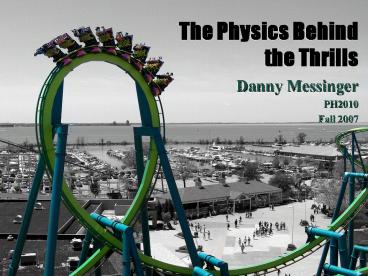The Physics Behind the Thrills - PowerPoint PPT Presentation
Title:
The Physics Behind the Thrills
Description:
'Centrifugal force' is actually the rider's inertia trying to keep them ... Knight, Randall; Physics for Scientists and Engineers; 2004; 182 - 200 ... – PowerPoint PPT presentation
Number of Views:240
Avg rating:3.0/5.0
Title: The Physics Behind the Thrills
1
The Physics Behind the Thrills
- Danny Messinger
- PH2010
- Fall 2007
2
A Brief History
- Russian Ice Slides
- Montagnes Russes
- Switchback Railway
- Scenic Railway
- Modern Roller Coaster
3
A Few Powerful Ideas
A few basic laws and ideas are used to provide
riders with a safe and thrilling experience
- Acceleration, Jerk and Snap
- Conservation of Energy
- Weightlessness
- Centripetal Acceleration
- Clothoid Loops
4
Acceleration, Jerk and Snap
- Acceleration - first derivative of velocity
- Positive and negative G-Forces
- Typical range from 4G to -1G
- Jerk - second derivative of velocity
- Rate of change of acceleration
- Riders need time to changes and adjust muscle
tension - Snap - third derivative of velocity
A roller coaster designer must have a
comprehensive knowledge of kinematics in order to
guarantee an exciting (and safe) ride
5
All About Energy
- Potential Energy
- The energy of position
- U mgh
- As the train climbs the lift hill, it is building
- potential energy
- Kinetic Energy
- The energy of motion
- K 1/2mv2
- As the train travels down a hill, its velocity
- increases which increases its kinetic energy
6
Conservation of Energy
- Ideally, the law of conservation of energy
provides a good model for roller coasters - Esystem K U
- Realistically, the law of conservation only
provides a basic tool for analyzing roller
coasters
7
Friction
- Friction is what eventually brings your ride to
an end - Dissipative force
- Esystem Emechanical Ethermal
- ?Esystem 0
8
Weightlessness
- Parabolic hills cause the sensation of
weightlessness - Riders are experiencing freefall due to this
trajectory
9
Centripetal Acceleration
ac v2 / r
- Points toward center of circular path
- Felt by riders as a force pushing them into their
seats - Centrifugal force is actually the riders
inertia trying to keep them continuing in a
straight path - Higher velocity higher ac
- Smaller radius higher ac
10
Feeling Loopy
11
The Clothoid Loop
- The characteristic upside-down teardrop shape
is found on all modern coasters - Minimizes forces on riders and allows a higher
entry speed - Early circular loops pulled over 13 Gs
- Modern clothoid loops pull only 3-4 Gs
- Circular loops would result in high jerk - a
dangerous problem
12
Linear Induction Motors
- A linear induction motor provides an alternative
to the traditional chain lift - Powered through alternating current
- Space-saving alternative to lift hill
- Exciting launch sensation
13
Bibliography
- Coasterimage www.coasterimage.com
- Knight, Randall Physics for Scientists and
Engineers 2004 182 - 200 - Roller Coaster Database www.rcdb.com
- Roller Coaster Physics http//ffden-2.phys.uaf.ed
u/211_fall2002.web.dir/ - Ultimate Roller Coaster Roller Coaster History
http//www.ultimaterollercoaster.com/coasters/hist
ory/ - Wikipedia Roller Coasters http//en.wikipedia.or
g/wiki/Roller_coasters
14
Any Questions?



























![[PDF]❤️DOWNLOAD⚡️ A Waiter in Paris: Adventures in the Dark Heart of the City PowerPoint PPT Presentation](https://s3.amazonaws.com/images.powershow.com/10128499.th0.jpg?_=20240910113)
![[PDF]❤️DOWNLOAD⚡️ A Waiter in Paris: Adventures in the Dark Heart of the City PowerPoint PPT Presentation](https://s3.amazonaws.com/images.powershow.com/10129023.th0.jpg?_=20240911077)
![[PDF]❤️DOWNLOAD⚡️ A Waiter in Paris: Adventures in the Dark Heart of the City PowerPoint PPT Presentation](https://s3.amazonaws.com/images.powershow.com/10132273.th0.jpg?_=202409171111)

